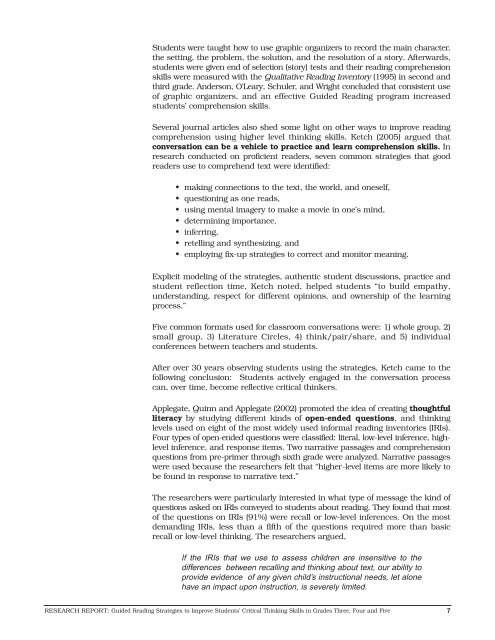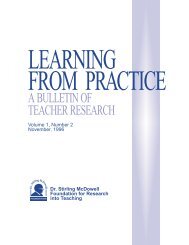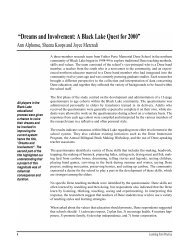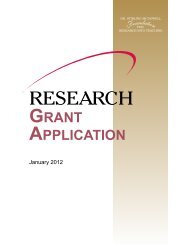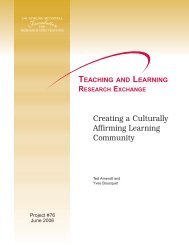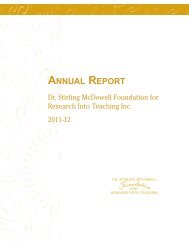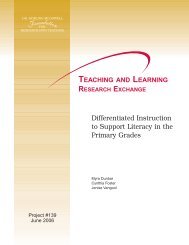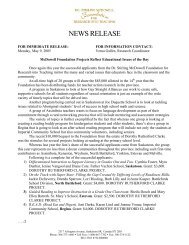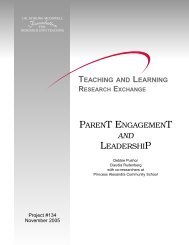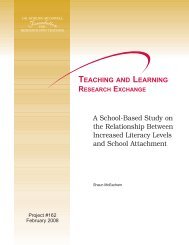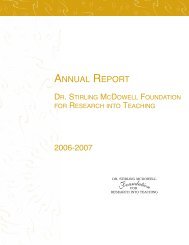Guided Reading Strategies to Improve Students - Dr. Stirling ...
Guided Reading Strategies to Improve Students - Dr. Stirling ...
Guided Reading Strategies to Improve Students - Dr. Stirling ...
- No tags were found...
Create successful ePaper yourself
Turn your PDF publications into a flip-book with our unique Google optimized e-Paper software.
<strong>Students</strong> were taught how <strong>to</strong> use graphic organizers <strong>to</strong> record the main character,the setting, the problem, the solution, and the resolution of a s<strong>to</strong>ry. Afterwards,students were given end of selection (s<strong>to</strong>ry) tests and their reading comprehensionskills were measured with the Qualitative <strong>Reading</strong> Inven<strong>to</strong>ry (1995) in second andthird grade. Anderson, O’Leary, Schuler, and Wright concluded that consistent useof graphic organizers, and an effective <strong>Guided</strong> <strong>Reading</strong> program increasedstudents’ comprehension skills.Several journal articles also shed some light on other ways <strong>to</strong> improve readingcomprehension using higher level thinking skills. Ketch (2005) argued thatconversation can be a vehicle <strong>to</strong> practice and learn comprehension skills. Inresearch conducted on proficient readers, seven common strategies that goodreaders use <strong>to</strong> comprehend text were identified:• making connections <strong>to</strong> the text, the world, and oneself,• questioning as one reads,• using mental imagery <strong>to</strong> make a movie in one’s mind,• determining importance,• inferring,• retelling and synthesizing, and• employing fix-up strategies <strong>to</strong> correct and moni<strong>to</strong>r meaning.Explicit modeling of the strategies, authentic student discussions, practice andstudent reflection time, Ketch noted, helped students “<strong>to</strong> build empathy,understanding, respect for different opinions, and ownership of the learningprocess.”Five common formats used for classroom conversations were: 1) whole group, 2)small group, 3) Literature Circles, 4) think/pair/share, and 5) individualconferences between teachers and students.After over 30 years observing students using the strategies, Ketch came <strong>to</strong> thefollowing conclusion: <strong>Students</strong> actively engaged in the conversation processcan, over time, become reflective critical thinkers.Applegate, Quinn and Applegate (2002) promoted the idea of creating thoughtfulliteracy by studying different kinds of open-ended questions, and thinkinglevels used on eight of the most widely used informal reading inven<strong>to</strong>ries (IRIs).Four types of open-ended questions were classified: literal, low-level inference, highlevelinference, and response items. Two narrative passages and comprehensionquestions from pre-primer through sixth grade were analyzed. Narrative passageswere used because the researchers felt that “higher-level items are more likely <strong>to</strong>be found in response <strong>to</strong> narrative text.”The researchers were particularly interested in what type of message the kind ofquestions asked on IRIs conveyed <strong>to</strong> students about reading. They found that mos<strong>to</strong>f the questions on IRIs (91%) were recall or low-level inferences. On the mostdemanding IRIs, less than a fifth of the questions required more than basicrecall or low-level thinking. The researchers argued,If the IRIs that we use <strong>to</strong> assess children are insensitive <strong>to</strong> thedifferences between recalling and thinking about text, our ability <strong>to</strong>provide evidence of any given child’s instructional needs, let alonehave an impact upon instruction, is severely limited.RESEARCH REPORT: <strong>Guided</strong> <strong>Reading</strong> <strong>Strategies</strong> <strong>to</strong> <strong>Improve</strong> <strong>Students</strong>’ Critical Thinking Skills in Grades Three, Four and Five7


